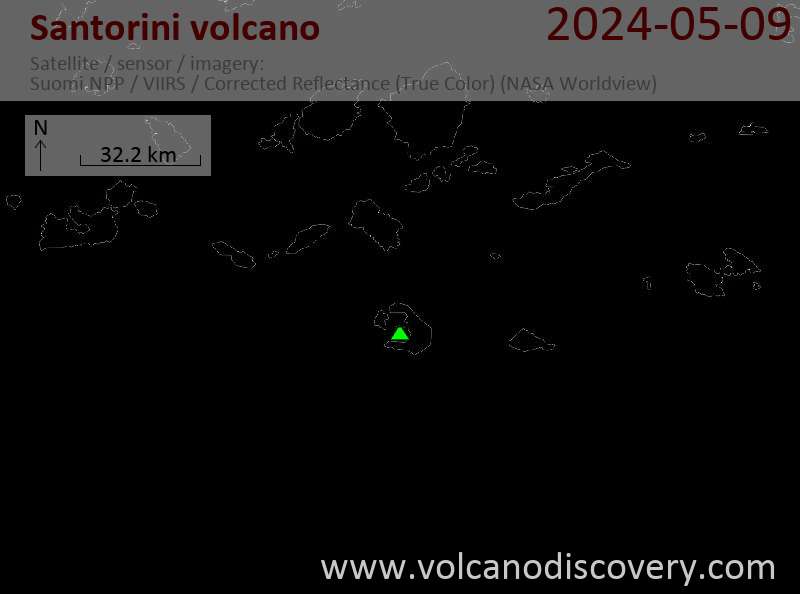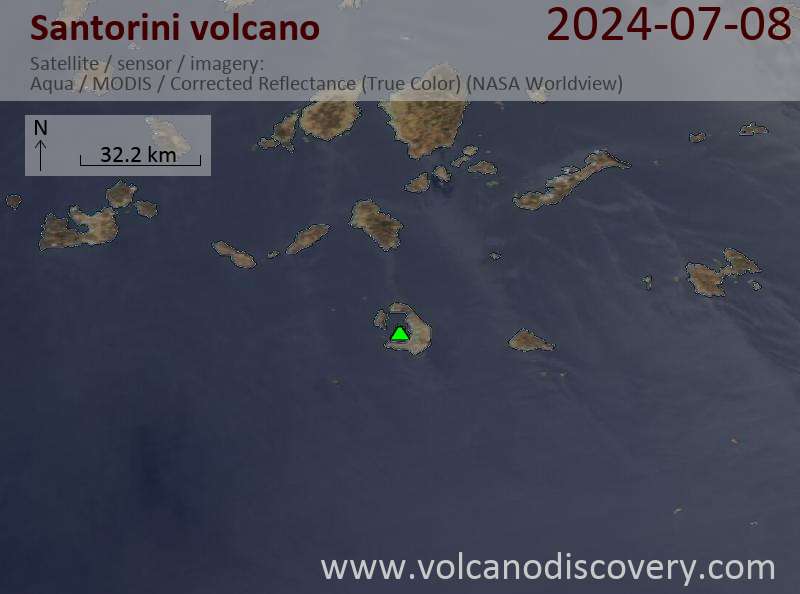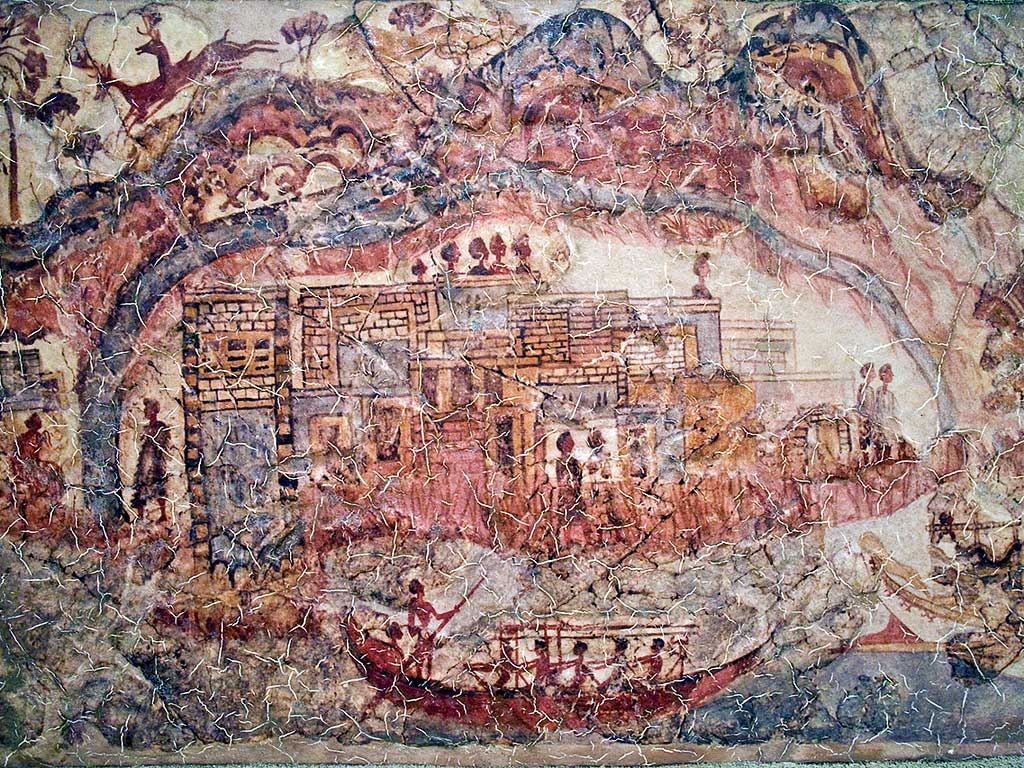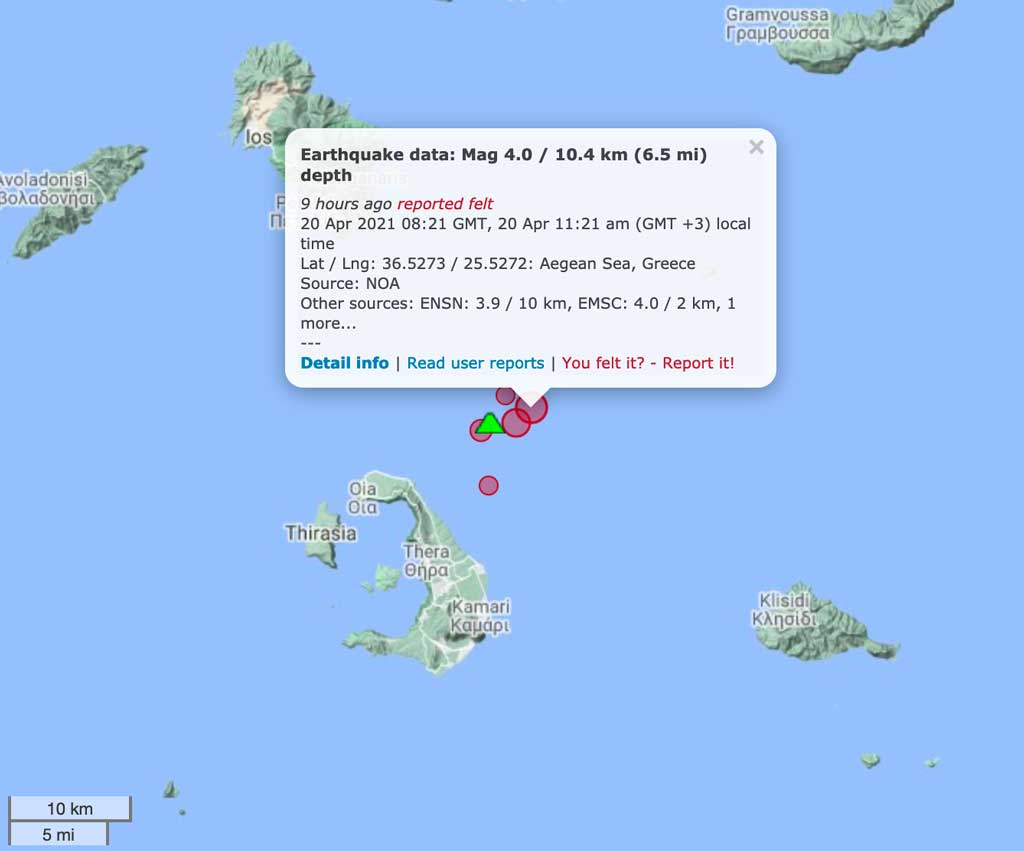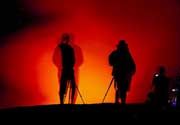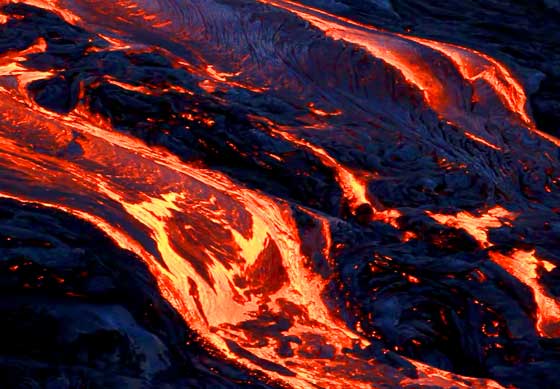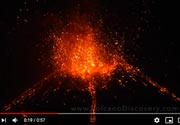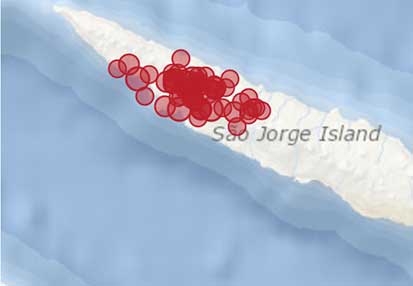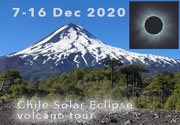Santorini Volcano
Updated: 16 avril. 2024 23:04 GMT -
Caldera (complex stratovolcano) 329 m (on caldera rim) / 128 m (top of most recent lava shield, Nea Kameni)
Cyclades, Greece, 36.4°N / 25.4°E
Condition actuelle: normal / en sommeil (1 sur 5)
Cyclades, Greece, 36.4°N / 25.4°E
Condition actuelle: normal / en sommeil (1 sur 5)
Last update: 6 mars 2022 (seismic swarm off the southwest of the island)
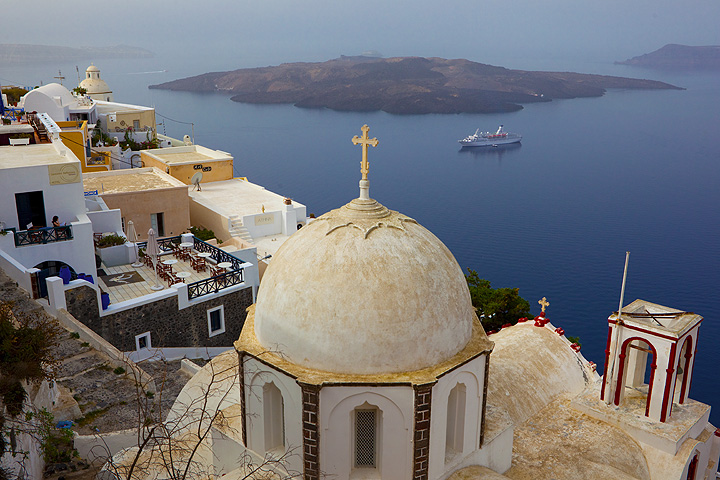
View of the caldera of Santorini from Fira town, with the young volcanic island of Nea Kameni in the background.
Santorini is a volcanic Island group at the central south end of the Cyclades in the Aegean Sea (Greece). As a popular tourist destination in Greece, it is renowned for its spectacular sea-filled volcanic caldera sourrounded by steep colorful cliffs, the beauty of its villages and fields.
[smaller] [larger]
Eruptions du volcan Santorini: 1613 BC +-7 years (the so-called "Minoan eruption", one of the largest plinian eruptions during the past 10,000 years on earth)
historic eruptions: 197 BC, 46/47 AD, 726, 1570-1573, 1707-1711, 1866-1870, 1925-1928, 1939-1941, 1950
Derniers séismes proches
| Heure | Mag. / Profondeur | Distance / Lieu | |||
| 10 avril 06:04 (Athens) | 2.0 21 km | 7.1 km au nord-est | Info | ||
| 10 avril 05:58 (Athens) | 2.9 8.3 km | 16 km au nord-est | Info | ||
| lundi, 8 avril 2024 GMT (1 séisme) | |||||
| 8 avril 20:29 (Athens) | 2.9 91 km | 18 km au sud-ouest | Info | ||
Introduction
The island group of Santorini is the most well-known and active volcanic centre of the Hellenic Volcanic Arc in the south Aegean Sea. It is a very complex stratovolcano dominated by a large, sea-flooded caldera created by several large explosive eruptions. The different products of about 2 million years of volcanic activity have accumulated around a small non-volcanic basement, that once formed a small island similar to the other cycladic islands. Most of the volcanic layers are visible in the multi-colored sequences of the impressive steep inner walls of the caldera, striking the visitor who reaches the island by boat.The last eruption took place in an phreatic eruption on Nea Kameni island in 1950.The Minoan Eruption
Santorini's volcanic activity during the past 2-500,000 years has been dominated by very large explosive eruptions at intervals of few tens of thousands of years. The most recent of this type occurred at around 1613 BC and is known as the so-called Minoan eruption. The late Bronze Age eruption, one of the biggest known volcanic explosions in younger time,- and one of the most studied, but still most mysterious eruptions of all time-, devastated not only Santorini, but had a deep impact on the whole of the Eastern Mediterranean. Perhaps it even had serious world-wide effects and changed history.
Still today, one can see its deposits, the characteristic, tens of meters thick layer of white pumice and ash that blankets most of the surface of the island group. The eruption changed the shape of the island itself dramatically: it is now believed that before the eruption, it had the shape of an almost complete ring that enclosed an earlier, shallower caldera. Then, large sections of island collapsed into the emptied magma chamber after the eruption, literally disappearing under the sea. The ring-island was breached to the W and NW, and the caldera was significantly widened and deepened.
The Minoan eruption devastated the rich, highly developed economic center, that Santorini was at that time. Since 1969, intense archaeological excavations have brought to light an important Cycladic/Minoan town which had been buried beneath the volcanic ash for almost 4000 years. Although it appears that people had time to evacuate their island in time before the eruption, carrying most of their goods with them, the findings from Akrotiri are impressive: especially, they include well-preserved and magnificent wall paintings, ceramics and other objects. Thanks to the work of numerous archaeologists, a new light was thrown on an important prehistoric period and culture. The spectacular discovery even induced continuing speculations that relate the volcanic destruction of Santorini to the legend of the sunken Atlantis.
The historic eruptions of Santorini volcano (Palea and Nea Kameni)
Although at present dormant, Santorini has been active several times in historic time. Since its last major explosive eruption (at about 1645 BC) numerous minor and medium-sized, mainly effusive eruptions have occurred. This activity built the dark-colored islands of Nea and Palea Kameni inside the caldera. Their first appearance was witnessed and reported by Greek and Roman writers. The last eruption on Nea Kameni occurred in 1950. At present, Santorini is dormant, and volcanism manifests as fumarolic activity and hot springs around the islands.
Santorini Volcano Photos
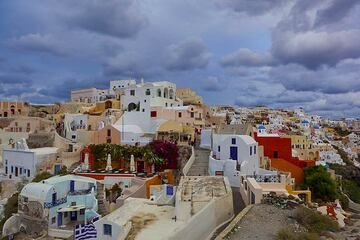
Ville d'Oia, Santorin (Photo: Tom Pfeiffer)
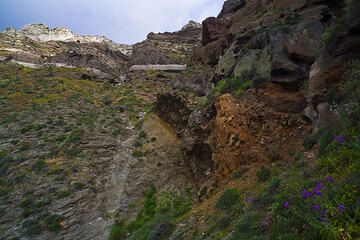
Le contact entre le socle métamorphique et les roches volcaniques (Photo: Tom Pfeiffer)
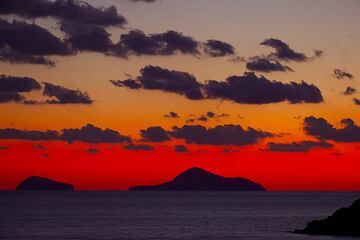
Coucher de soleil coloré à Akrotiri (Santorin), en octobre 2011, avec une vue extrêmement dégagée sur les îles volcaniques de Christiania. (Photo: Tom Pfeiffer)
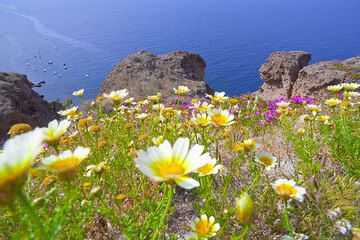
Marguerites et caldeira près d'Akrotiri (Photo: Tom Pfeiffer)
Eruptions du volcan Santorini
1950 eruption
10. Jan. 1950 - 2. Feb. 1950: Small effusive activity ("Liatsikas" lavas) preceded by phreatic explosions.
More info
10. Jan. 1950 - 2. Feb. 1950: Small effusive activity ("Liatsikas" lavas) preceded by phreatic explosions.
More info
1939-41 eruption
20. Aug. 1939 - July 1941 -- Formation of several lava domes ("Tritona", "Ktenas", "Fouqué", "Smith-Reck" and "Niki"). Extrusive and slighly explosive activity. Lava outflow in most cases preceeded by phreatic explosions.
more info
20. Aug. 1939 - July 1941 -- Formation of several lava domes ("Tritona", "Ktenas", "Fouqué", "Smith-Reck" and "Niki"). Extrusive and slighly explosive activity. Lava outflow in most cases preceeded by phreatic explosions.
more info
1925-28 eruption
11. Aug. 1925- 17. March 1928 -- Moderate effusive and explosive activity. Growth of Nea Kameni. Lava flows, lava fountains and ash-falls.
- Aug. 1925 -- Rising temperature in the Red bay ("Kokkina Nera", gr. = red waters) at the eastern shore of Nea Kameni and subsidence of Nea Kameni's east shore. Vapor fountains and lava outflow. ...plus d'info
11. Aug. 1925- 17. March 1928 -- Moderate effusive and explosive activity. Growth of Nea Kameni. Lava flows, lava fountains and ash-falls.
- Aug. 1925 -- Rising temperature in the Red bay ("Kokkina Nera", gr. = red waters) at the eastern shore of Nea Kameni and subsidence of Nea Kameni's east shore. Vapor fountains and lava outflow. ...plus d'info
1866-1870 eruption
4. Feb. 1866 - 15. Oct. 1870 -- Moderate effusive and minor explosive activity. Mikri and Nea Kameni unite. Lava flows, lava fountains and ash-falls. ...plus d'info
4. Feb. 1866 - 15. Oct. 1870 -- Moderate effusive and minor explosive activity. Mikri and Nea Kameni unite. Lava flows, lava fountains and ash-falls. ...plus d'info
1711 - 1866 activity
No volcanic activity occurred during 1711-1866. Mikri and Nea Kameni were 2 separated islands forming 2 natural bays (Georgios and Vulkano bay). Sulfuric fumaroles in Vulkano bay. Building of a small harbor and ca. 50 summerhouses (!) on Nea Kameni.
No volcanic activity occurred during 1711-1866. Mikri and Nea Kameni were 2 separated islands forming 2 natural bays (Georgios and Vulkano bay). Sulfuric fumaroles in Vulkano bay. Building of a small harbor and ca. 50 summerhouses (!) on Nea Kameni.
1707-1711 eruption: Nea Kameni appears
23. May 1707 - Sept. 1711 -- Formation of Nea Kameni (gr., = "the new burnt island"). Strong surtseyan and effusive activity. Ash-fall and gas explosions. Lowering of the coastline of Thera and Mikri Kameni. ...plus d'info
23. May 1707 - Sept. 1711 -- Formation of Nea Kameni (gr., = "the new burnt island"). Strong surtseyan and effusive activity. Ash-fall and gas explosions. Lowering of the coastline of Thera and Mikri Kameni. ...plus d'info
1650 Kolumbo volcano eruption
27. Sept 1650 -- Kolumbo submarine volcano (ca. 8 km NE of Cape Kolumbo, Santorini): strong surtseyan-subplinian eruption with ash and pumice fall, toxic gasses (>50 fatalities). Generation of a strong tsunami.
more info on Kolumbo volcano
27. Sept 1650 -- Kolumbo submarine volcano (ca. 8 km NE of Cape Kolumbo, Santorini): strong surtseyan-subplinian eruption with ash and pumice fall, toxic gasses (>50 fatalities). Generation of a strong tsunami.
more info on Kolumbo volcano
1570 eruption: Mikri Kameni Island appears
Formation of Mikri Kameni (gr., = "small burnt island"). Surtseyan activity, ash-fall and block fall-out accompany the formation of a lava dome which rises above sea level to form the new island Mikri Kameni.
Formation of Mikri Kameni (gr., = "small burnt island"). Surtseyan activity, ash-fall and block fall-out accompany the formation of a lava dome which rises above sea level to form the new island Mikri Kameni.
1457-1458 activity
Unclear reports from Athanasius Kircher (1665) and Buondelmonte (1465/66) indicate that either a part of Palea Kameni collapsed and disappeared or a new island between Palea Kameni and Thera was built.
Unclear reports from Athanasius Kircher (1665) and Buondelmonte (1465/66) indicate that either a part of Palea Kameni collapsed and disappeared or a new island between Palea Kameni and Thera was built.
726 AD subplinian (?) eruption
Strong explosive probably sub-plinian eruption. Records by Nicephoros (758-823), Theophanes (752-818) and Cedremus (after 1059). Probably small effusive activity following the pumice eruption creating the black blocky lava lobe at Agios Nikolaos (the small harbor bay with the church and hot iron springs).
Strong explosive probably sub-plinian eruption. Records by Nicephoros (758-823), Theophanes (752-818) and Cedremus (after 1059). Probably small effusive activity following the pumice eruption creating the black blocky lava lobe at Agios Nikolaos (the small harbor bay with the church and hot iron springs).
46 - 726 AD activity
No reports of activity are known from that period. There was either actually no eruption or it has not been recorded.
No reports of activity are known from that period. There was either actually no eruption or it has not been recorded.
46 AD eruption - appearance of a new island
Appearance of a new island that probably grew together with Hiera and formed the basis of Palea Kameni. Descriptions by Roman historians Seneca (4 BC-65 AD), Livy (59 BC-AD 17), Pliny the Elder (23-79 AD), Dio Cassius (ca. 200 AD), Aurelius Victor (4th century AD), Philostratos (ca. 200 AD), Orosius (5th century AD), Cassiodorus. (418-562 AD), Labbreus (1670). Probably surtseyan activity with updoming of the sea-floor.
Appearance of a new island that probably grew together with Hiera and formed the basis of Palea Kameni. Descriptions by Roman historians Seneca (4 BC-65 AD), Livy (59 BC-AD 17), Pliny the Elder (23-79 AD), Dio Cassius (ca. 200 AD), Aurelius Victor (4th century AD), Philostratos (ca. 200 AD), Orosius (5th century AD), Cassiodorus. (418-562 AD), Labbreus (1670). Probably surtseyan activity with updoming of the sea-floor.
197 BC eruption: appearance of Palea Kameni
Formation of an island called Hiera (gr., = "the holy one") inside the caldera, probably a precursor of Palea Kameni. Documented by greek and Roman writers: Strabo (66BC - 24 AD), Plutarch (ca. 40-120 AD), Pausanias (ca.120 AD), Justinus (2nd century AD), Eusebius from Cesarea (270-340 AD) and Ammianus Marcellinus (ca. 330-400 AD). Probably surtseyan activity with updoming of the sea-floor (comparable with the 1707-1711 events).
Formation of an island called Hiera (gr., = "the holy one") inside the caldera, probably a precursor of Palea Kameni. Documented by greek and Roman writers: Strabo (66BC - 24 AD), Plutarch (ca. 40-120 AD), Pausanias (ca.120 AD), Justinus (2nd century AD), Eusebius from Cesarea (270-340 AD) and Ammianus Marcellinus (ca. 330-400 AD). Probably surtseyan activity with updoming of the sea-floor (comparable with the 1707-1711 events).
1613 +- 13 BC Minoan eruption
The most recent plinian eruption on Santorini occurred in the late Bronze Age at around 1613 BC and is known as the so-called Minoan eruption. It is one the biggest known volcanic explosions in younger time,- and one of the most studied, but still most mysterious eruptions of all time-. It devastated not only Santorini, but had a deep impact on the whole of the Eastern Mediterranean. Perhaps it even had serious world-wide effects and changed history.
Size of the Minoan eruption
Dating of the Minoan eruption
Still today, one can see its deposits, the characteristic, tens of meters thick layer of white pumice and ash that blankets most of the surface of the island group. The eruption changed the shape of the island itself dramatically: it is now believed that before the eruption, it had the shape of an almost complete ring that enclosed an earlier, shallower caldera.
Large sections of island collapsed into the emptied magma chamber after the eruption, literally disappearing under the sea. The ring-island was breached to the W and NW, and the caldera was significantly widened and deepened.
The Minoan eruption devastated the rich, highly developed economic center, that Santorini was at that time. Since 1969, intense archaeological excavations have brought to light an important Cycladic/Minoan town which had been buried beneath the volcanic ash for almost 4000 years. Although it appears that people had time to evacuate their island in time before the eruption, carrying most of their goods with them, the findings from Akrotiri are impressive: especially, they include well-preserved and magnificent wall paintings, ceramics and other objects. Thanks to the work of numerous archaeologists, a new light was thrown on an important prehistoric period and culture. The spectacular discovery even induced continuing speculations that relate the volcanic destruction of Santorini to the legend of the sunken Atlantis.
The most recent plinian eruption on Santorini occurred in the late Bronze Age at around 1613 BC and is known as the so-called Minoan eruption. It is one the biggest known volcanic explosions in younger time,- and one of the most studied, but still most mysterious eruptions of all time-. It devastated not only Santorini, but had a deep impact on the whole of the Eastern Mediterranean. Perhaps it even had serious world-wide effects and changed history.
Size of the Minoan eruption
Dating of the Minoan eruption
Still today, one can see its deposits, the characteristic, tens of meters thick layer of white pumice and ash that blankets most of the surface of the island group. The eruption changed the shape of the island itself dramatically: it is now believed that before the eruption, it had the shape of an almost complete ring that enclosed an earlier, shallower caldera.
Large sections of island collapsed into the emptied magma chamber after the eruption, literally disappearing under the sea. The ring-island was breached to the W and NW, and the caldera was significantly widened and deepened.
The Minoan eruption devastated the rich, highly developed economic center, that Santorini was at that time. Since 1969, intense archaeological excavations have brought to light an important Cycladic/Minoan town which had been buried beneath the volcanic ash for almost 4000 years. Although it appears that people had time to evacuate their island in time before the eruption, carrying most of their goods with them, the findings from Akrotiri are impressive: especially, they include well-preserved and magnificent wall paintings, ceramics and other objects. Thanks to the work of numerous archaeologists, a new light was thrown on an important prehistoric period and culture. The spectacular discovery even induced continuing speculations that relate the volcanic destruction of Santorini to the legend of the sunken Atlantis.
Latest satellite images
Santorini Volcano Tours
Santorini Island (Greece)
Santorini Geology Tour
private tours to discover Santorini's geology with a volcanologist, 1-3 days
1-3 days - Variable (dépendant de l'itinéraire choisi et vos préférences)
Prix from 750 EUR
Prix from 750 EUR
Départs sur commande possibles
Île de Santorin, Grèce
Fascinant Volcan et la Légende de l'Atlantide
8 (ou 9) jours de découvertes géologiques et de splendides randonnées à Santorin, Grèce
8 / 9 jours - Modérée
Prix 1690 €
Prix 1690 €
April 2025 (exact date soon)





